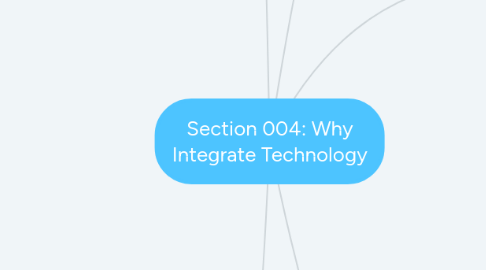
1. Teaching Should Be Different
1.1. Be as current as your students
1.2. Prepare in and out of school
1.3. Technology surrounds students everyday
1.4. Universal Design for Learning
1.4.1. Multiple means of representation
1.4.1.1. This is the what of learning
1.4.1.2. This principle works with the recognition network of the brain
1.4.1.3. To give learners diverse options for acquiring knowledge and receiving information
1.4.2. Multiple means of expression
1.4.2.1. This is the how of learning
1.4.2.2. This principle works with the strategic network of the brain
1.4.2.3. To provide learners with options to demonstrate what they've learned
1.4.3. Multiple means of engagement
1.4.3.1. This is the why of learning
1.4.3.2. This principle works with the affective network of the brain
1.4.3.3. To address learner's interests, provide appropriate challenges, and increase motivation
1.5. Digital Video
1.5.1. Facilitating thinking and problem solving
1.5.2. Assisting with mastery learning
1.5.3. Inspiring and engaging students
1.5.4. Authentic learning opportunities
2. Standards Are Different
2.1. Adding to most institutions
2.2. Be aware of standards to help students meet them
2.3. ISTE - International Society for Technology in Education
2.3.1. Copyright and Fair Use
2.3.1.1. Educators
2.3.1.1.1. 3b: Citizen: Establish a learning culture that promotes curiosity and critical examination of online resources and fosters digital literacy and media fluency.
2.3.1.1.2. 3c: Citizen: Mentor students in the safe, legal and ethical practices with digital tools and the protection of intellectual rights and property.
2.3.1.1.3. 3d: Citizen: Model and promote management of personal data and digital identity and protect student data privacy.
2.3.1.2. Students
2.3.1.2.1. 2b: Digital Citizen: engage in positive, safe, legal and ethical behavior when using technology, including social interactions online or when using networked devices.
2.3.1.2.2. 2c: Digital Citizen: Demonstrating an understanding of of and respect for the rights and obligations of using and sharing intellectual property.
2.3.1.2.3. 2d: Digital Citizen: manage their personal data to maintain digital privacy and security and are aware of data-collection technology used to track their navigation online.
2.3.2. Safe Use of the Internet
2.3.2.1. Educators
2.3.2.1.1. 3a: Citizen: Create experiences for learners to make positive, socially responsible contributions and exhibit empathetic behavior online that build relationships and community.
2.3.2.1.2. 3c: Citizen: Mentor students in the safe, legal and ethical practices with digital tools and the protection of intellectual rights and property.
2.3.2.1.3. 3d: Citizen: Model and promote management of personal data and digital identity and protect student data privacy.
2.3.2.2. Students
2.3.2.2.1. 2a: Digital Citizen: cultivate and manage their digital identity and reputation and are aware of the permanence of their actions in the digital world.
2.3.2.2.2. 2b: Digital Citizen: engage in positive, safe, legal and ethical behavior when using technology, including social interactions online or when using networked devices.
2.3.2.2.3. 2c: Digital Citizen: demonstrate an understanding of and respect for the rights and obligations of using and sharing intellectual property.
2.3.3. Cyberbullying
2.3.3.1. Educators
2.3.3.1.1. 3a: Citizen: Create experiences for learners to make positive, socially responsible contributions and exhibit empathetic behavior online that build relationships and community.
2.3.3.1.2. 3d: Citizen: Model and promote management of personal data and digital identity and protect student data privacy.
2.3.3.2. Students
2.3.3.2.1. 2a: Digital Citizen: cultivate and manage their digital identity and reputation and are aware of the permanence of their actions in the digital world.
2.3.3.2.2. 2b: Digital Citizen: engage in positive, safe, legal and ethical behavior when using technology, including social interactions online or when using networked devices.
2.4. Ohio Technology Standards
2.5. Ohio Learning Standards
3. The World is Different
3.1. Need special 21st century skills
3.2. Globalization
3.3. Flexibility
3.4. Spatial Literacy
4. The Students Are Different
4.1. Digital Natives
4.2. Alien without technology
4.3. Always on or connected
4.4. Comfortable Multitasking
4.5. Impatient, Creative, and Social
4.6. All types of learners
4.6.1. Intelligence Preference
4.6.2. Culture or ethnicity
4.6.3. Special Needs
4.6.4. Autism
4.6.5. Intellectual disabilities
4.6.6. ADHD/ADD
4.6.7. Learning disabilities
4.6.8. Learning Style
4.6.9. Language
4.6.10. Physical disabilities
4.6.11. Students at risk
4.6.12. Gifted or Talented
5. Skills Are Different
5.1. Redesign classroom for student skill learning
5.2. Practice of skills is essential
5.3. 21st century skills
5.3.1. Creativity and Innovation
5.3.2. Communication and Collaboration
5.3.3. Research and Information Literacy
5.3.4. Critical Thinking
5.3.5. Nonlinear Thinking
5.3.6. Visual Literacy and Visual Thinking
5.3.7. Spatial Thinking
5.3.8. Digital Age Reflection

